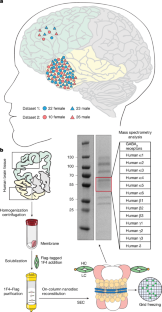2025-01-22 カリフォルニア大学サンディエゴ校 (UCSD)
<関連情報>
- https://today.ucsd.edu/story/epilepsy-patient-samples-offer-unprecedented-insights-on-brain-brakes-linked-to-disorders
- https://www.nature.com/articles/s41586-024-08454-1
ヒト脳のGABAA受容体ネイティブ構造の解明 Resolving native GABAA receptor structures from the human brain
Jia Zhou,Colleen M. Noviello,Jinfeng Teng,Haley Moore,Bradley Lega & Ryan E. Hibbs
Nature Published:22 January 2025
DOI:https://doi.org/10.1038/s41586-024-08454-1

Abstract
Type A GABA (γ-aminobutyric acid) receptors (GABAA receptors) mediate most fast inhibitory signalling in the brain and are targets for drugs that treat epilepsy, anxiety, depression and insomnia and for anaesthetics1,2. These receptors comprise a complex array of 19 related subunits, which form pentameric ligand-gated ion channels. The composition and structure of native GABAA receptors in the human brain have been inferred from subunit localization in tissue1,3, functional measurements and structural analysis from recombinant expression4,5,6,7 and in mice8. However, the arrangements of subunits that co-assemble physiologically in native human GABAA receptors remain unknown. Here we isolated α1 subunit-containing GABAA receptors from human patients with epilepsy. Using cryo-electron microscopy, we defined a set of 12 native subunit assemblies and their 3D structures. We address inconsistencies between previous native and recombinant approaches, and reveal details of previously undefined subunit interfaces. Drug-like densities in a subset of these interfaces led us to uncover unexpected activity on the GABAA receptor of antiepileptic drugs and resulted in localization of one of these drugs to the benzodiazepine-binding site. Proteomics and further structural analysis suggest interactions with the auxiliary subunits neuroligin 2 and GARLH4, which localize and modulate GABAA receptors at inhibitory synapses. This work provides a structural foundation for understanding GABAA receptor signalling and targeted pharmacology in the human brain.


